Every season has something spectacular to show at Hoyt Arboretum. Winter is no exception. Our Conifer Collection is green and commanding year-round. Witch-hazel, Camellia, Viburnum, Mahonia, Hellebores, and more can all be found blooming in the winter months.
Here are a few ideas of where to go and what to see at Hoyt Arboretum in Winter.
Redwoods
Big trees tower overhead in the deep woods of the Conifer Collection. Moss and lichens are at their greenest in winter, dappled with drops of water and almost glowing with neon colors. The route on the Arboretum map marked “One Hour Loop” clocks in just under a mile in length, with broad well-graded trails.
Near the juncture of the Fir Trail and the Redwood Trail, note the bright red stems of red osier dogwood. The open hillside above the ever-green Bamboo Garden will often be frosted white on nippy mornings.
The larches along the trail, while in the Pine family, are not evergreen, but deciduous. Their needles fall off after turning coppery in the Fall, leaving long, naked, knobby branches that droop down over the trail. Across Fischer Lane, the Redwood Trail dives into the deep forest, through the cedars and to the redwoods.
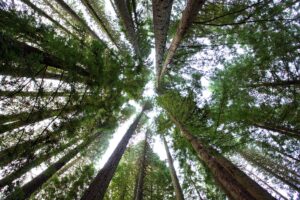
All three species of Redwoods can be found in the Redwood Grove along the Redwood Trail: giant sequoia (the biggest), coast redwood (the tallest), and dawn redwood (the oddest – another deciduous conifer). Most of these trees were planted nearly a hundred years ago, so they are towering, evoking the sense of an old growth grove. The experience at the Redwood Deck is particularly sublime in Winter.
Holly Loop
If you want some guaranteed color in Winter, you don’t have to go far from the Visitor Center. The Holly Loop starts at the south end of the parking lot. The “loop” is a short network of trails criss-crossing a hillside planted with dozens of varieties of hollies.

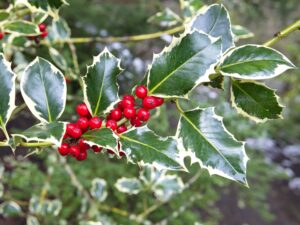
In addition to many bright red berries, evergreen leaves persist through the cold months, some with striking variegation. Switchback through the loop to see the most variety.
Witch-hazel
The spidery flowers of witch-hazel are some of the most interesting to be found. Not only do they bloom in December and January, but they unfurl to open, and will roll back up and down as the temperature fluctuates. When fully open, they look like little red and yellow fireworks bursts.

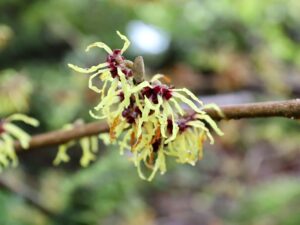
Witch-hazel can be found near the Oregon Vietnam Veterans Memorial and Parking Lot. There is also witch-hazel in the Winter Garden.
Winter Garden
The biggest Winter wows can usually be found in Hoyt Arboretum’s Winter Garden.
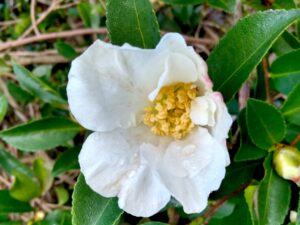

The “Showa-No-Sakae” Camellia puts on the biggest show of winter flowers (pink and white varieties shown above). Hellebores cover the ground with big-petalled blooms. Pink dawn Viburnum (shown below on the left) is perhaps one of the perfumiest of the winter flowers. And evergreen-leaved Mahonia stick up bright yellow spikes of flowers (shown below on the right).
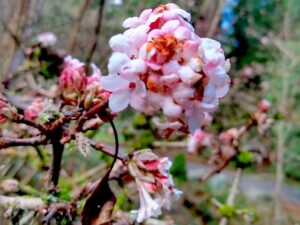
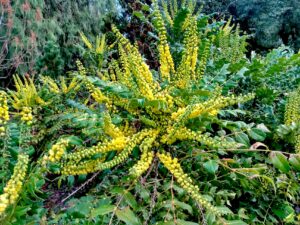
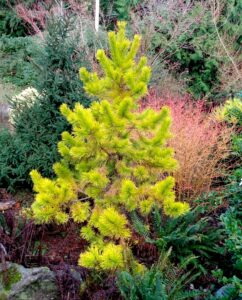
The Winter Garden was curated to represent not just winter blooms, but also plants that are interesting for colored and textured bark, stems and other features in Winter.
The “Golden” lodgepole pine (shown to the left) has needles that get a buttery yellow.
The “Winter Flame” coralbark maple loses its leaves, but its bark is brilliant orange-red. And the Himalayan birch has incredibly white bark.
Explore the Winter Garden
The Winter Garden can be found where the Beech Trail meets the Wildwood Trail, below the Magnolia Collection. (Feature #4 on the Trail Map)
Explore the plants of the Winter Garden in this self-guided digital tour: Winter Garden Self-Guided Tour.
Click the “Take the Tour” link, and it will take you to our Plant Database Tours page. Click on the box to open the drop-down menu and select “Winter Garden Tour (#17)”. A map and a list of highlighted plants will then appear. Download it to your phone before you set out, as cell reception can be spotty.
Check out this blog about the Winter Garden: Volunteer Voices: Winter Garden.
A Safe Winter Visit
Winters are usually mild in the Pacific Northwest, which means that the trails are open and accessible most of the year. While there can be weather events that make things icy, a light rain and a little mud is most often the worst to contend with.
On those rare occasions that snow blankets the Arboretum, it can be a beautiful sight. But then, please exercise caution. Here are some ways to prepare for a safe winter visit:
- Check out the “Recent Updates” page on our website to find out the latest conditions.
- See if the Explore Washington Park Free Shuttle is running.
- Visit Trimet’s Alerts page to see if buses and trains are running.
- Check the weather forecast so you know what to expect.
- Visit the Visitor Center once you arrive to find out the latest (4000 SW Fairview Blvd).
If it is icy, then be sure to dress in layers, wear traction devices on your boots, and bring poles for balance. Don’t head out if you are not prepared for the weather. And be especially careful crossing roads.
One of the joys of Portland is it’s mild winters. So long as you are prepared for some rain and and a bit of mud, then Hoyt Arboretum is a spectacular destination all year long.
 About the Author
About the Author
Greg Hill is a writer and naturalist with decades of visitor experience at Hoyt Arboretum. An avid hiker, he spent 10 years as a Northwest Mountaineer and Trail Guide. Greg volunteered for a year at the Visitor Center before becoming a Visitor Information Specialist for Hoyt Arboretum Friends.
